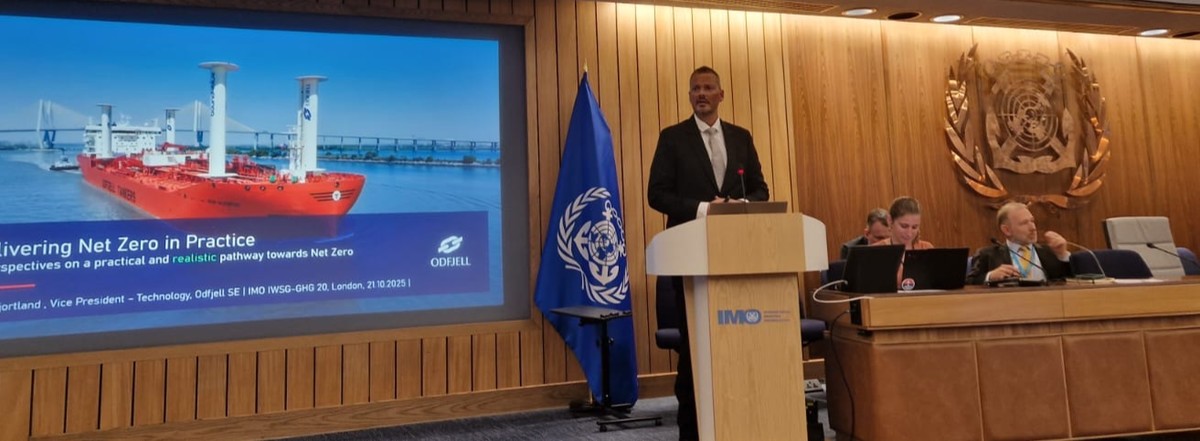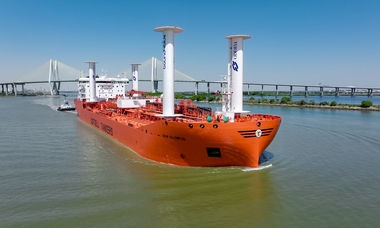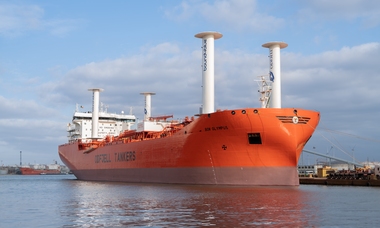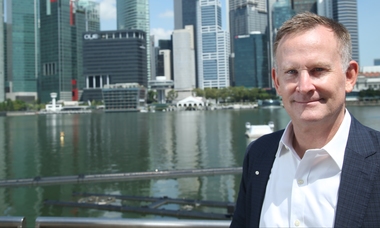This week, the International Maritime Organization (IMO) headquarters in London hosted the 20th Intersessional Working Group on Greenhouse Gases (ISWG-GHG 20). The meeting is a key technical-negotiation forum for IMO’s process to develop and finalize mid- and long-term measures to reduce greenhouse gas (GHG) emissions from international shipping.
Following the heated Net-Zero Framework debate the previous week, the meeting carried an unmistakable buzz. Then Erik Hjortland entered the stage and caught the attention with a clear message: the pathway to net-zero shipping is already within reach.
Real results from real operations
Odfjell’s chemical tanker Bow Olympus completed a transatlantic voyage earlier this year, powered by a dual propulsion solution: suction sails on deck, 100% waste-based, ISCC-certified biofuel meeting both IMO and the EU’s sustainability criteria in the bunker tanks.
The goal was to demonstrate the GHG reductions possible by utilizing options available here and now. The results might have surprised even the most hardcore optimists at Odfjell: it achieved a 20% consumption reduction due to the sails, and 85% reduction in well-to-wake greenhouse gas emissions due to the sustainable biofuel.
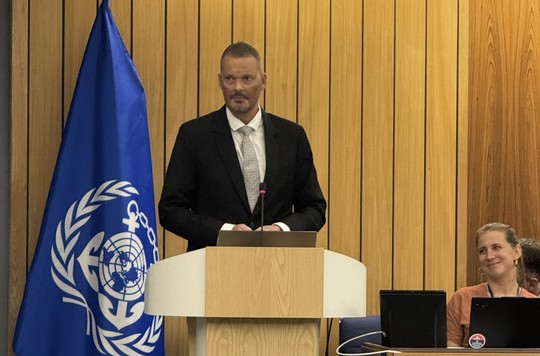
“This voyage shows that meaningful progress toward net zero is possible with existing technology and infrastructure.
For shipping to decarbonize, we cannot afford to overcomplicate the matter.
We need to identify the most cost-effective, environmentally friendly and scalable solutions, and sustainable biofuels may prove to be exactly that” – Erik Hjortland
Three key messages to IMO
Erik’s fact-based presentation resonated strongly with participants, anchored by three clear recommendations to regulators:
- Sustainable biofuels must not be discriminated compared to e-fuels in the regulations. “To ensure sustainability, a robust certification scheme is of course a prerequisite,” he emphasised. “Sustainable biofuels are available now, can be further scaled up, and they work.
He underlined the need for a holistic approach to energy use in shipping and highlighted the disproportionate energy demand of e-fuels, which could consume around 50% of global renewable electricity if scaled for deep-sea shipping. In contrast, sustainable biofuels requires just 1.5%
- Wind power is propulsive power. “Wind power must be properly rewarded in the regulations—on equal terms as net-zero or near-zero fuels,” he said, referencing the wind-assisted propulsion system on Bow Olympus, which reduced fuel consumption by up to 40% on parts of the voyage.
- Energy efficiency must not be neglected. “For rapid and business-sound GHG reductions, energy efficiency must be incentivized to stimulate further uptake of energy-saving devices,” he stated.

The delegates attending represented nations from around the world.
A scalable pathway
Scalability-wise, our VP Technology referred to DNV's 2023 research, which estimates a sufficient availability of sustainable biomass beyond 2050—for all sectors, including shipping. The supply estimates are cross-checked with 26 other reliable and credible sources, which show that DNV's predictions are quite conservative. The significance of this pathway is that it does not require capex, and as such, one can argue that the entire shipping fleet today is net-zero capable.
We have reduced the carbon intensity of our fleet by 54% since the 2008 benchmark through systematic efficiency improvements, including retrofitting of more than 140 energy-saving devices such as propeller upgrades, hull optimization, propeller ducts, LED lights, and sails. These measures have not only reduced emissions but also generated annual fuel cost savings of USD 20-30 million.
In contrast, 67% of the world fleet has not installed a single energy-saving device (according to Clarkson Research, 2024), leaving an enormous untapped potential for further emission reductions in the industry—and cost savings.
“We cannot energy-efficiency ourselves to zero, but we can get very far, very fast—and sustainable biofuels and wind power can take us the rest of the way,” Erik said. “With 10,000 tonnes of sustainable biofuel bunkered this year and more to come, we’re not just talking —we’re doing.”
